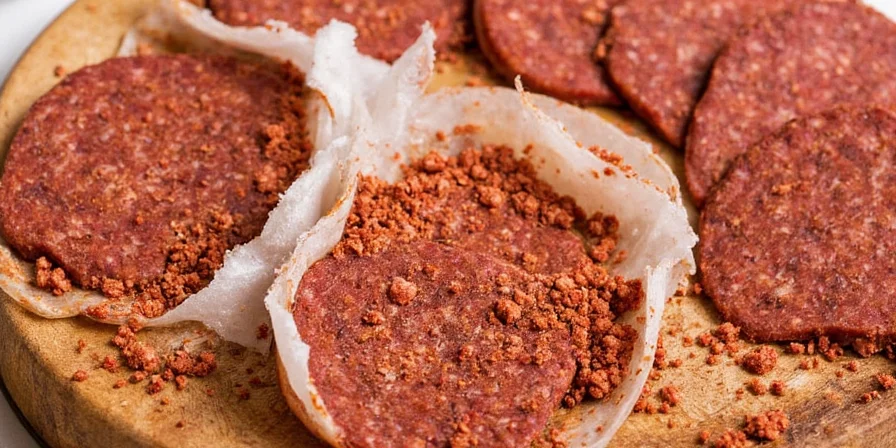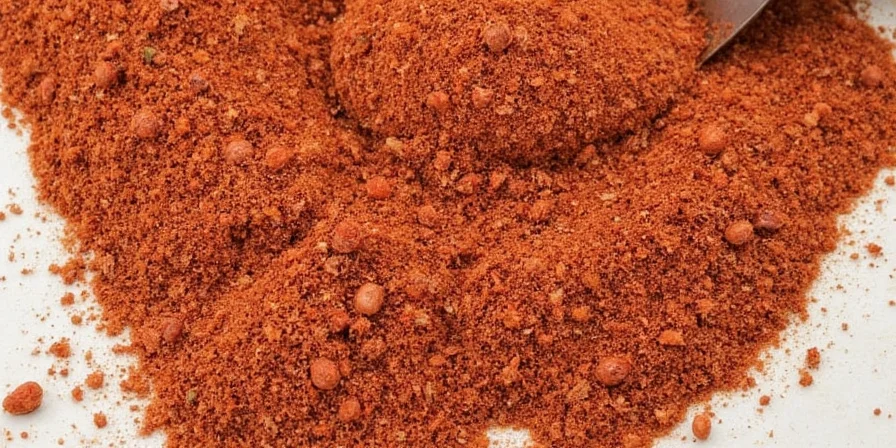For home cooks seeking to move beyond store-bought blends, this guide delivers complete control over flavor, health, and authenticity. Whether you're a novice or a seasoned chef, you'll gain the skills to craft chorizo seasoning that elevates any dish—from traditional Spanish tapas to inventive vegan creations. Discover why understanding spice chemistry transforms good seasoning into extraordinary culinary experiences.
Forget the butcher—grab your spice rack and master homemade chorizo seasoning through scientifically informed techniques. We'll explore the biochemical interactions that make paprika sing and vinegar preserve, ensuring your blend achieves flavor complexity impossible in commercial versions. Let's dive into the global spice science that has perfected chorizo for centuries.
Table of Contents
- What Is Chorizo Anyway?
- Why Go Homemade? A Flavor Revolution!
- Essential Ingredients for Authentic Chorizo Seasoning
- Step-by-Step Guide to Making Chorizo Seasoning at Home
- Pro Tips & Flavor Hacks
- Global Twists: Chorizo Variations Around the World
- Creative Ways to Use Your Homemade Chorizo Seasoning
- Frequently Asked Questions
- Final Thoughts
What Is Chorizo Anyway?
You've probably seen it on charcuterie boards, in paella pans, or tucked inside tacos—but what exactly is chorizo?
In short, chorizo is a highly seasoned sausage that comes in many forms across different cultures. The Spanish version is typically cured and sliced thin, while Mexican chorizo is fresh and meant to be cooked before eating. Both rely heavily on one key element:
- Paprika (smoked, sweet, or hot)
- Vinegar or wine
- Garlic
- Salt
- Pepper
The magic lies in how these ingredients interact at molecular level—the capsaicin in chilies binds with fat molecules, while vinegar's acetic acid accelerates flavor compound extraction from spices. That's where homemade chorizo seasoning unlocks superior results.

Why Go Homemade? A Flavor Revolution!
Store-bought seasoning often sacrifices complexity for shelf stability. Homemade versions leverage fresh spice compounds that degrade within weeks in commercial blends. You gain full control over:
- Heat Level: Dial it up or down depending on capsaicin solubility in your chosen fat base.
- Smokiness: Adjust smoked paprika ratios to manipulate phenolic compounds for campfire depth.
- Fat Chemistry: Control lipid content to optimize fat-soluble flavor compound distribution.
- Preservation Science: Replace synthetic preservatives with vinegar's natural antimicrobial properties.
| Store-Bought | Homemade |
|---|---|
| Limited customization | Full flavor control via spice chemistry |
| High sodium | Optimized salt levels for flavor enhancement |
| Synthetic preservatives | Natural preservation through pH control |
| Fixed flavor profile | Dynamic adjustments for ingredient freshness |
Essential Ingredients for Authentic Chorizo Seasoning
Here's the base recipe for 1 batch (enough for 2 lbs ground pork), optimized for maximum flavor compound extraction:
- 2 tbsp smoked paprika (contains 28+ volatile compounds for depth)
- 1 tsp garlic powder (allicin precursors activate with vinegar)
- ½ tsp onion powder
- ½ tsp dried oregano
- ½ tsp ground cumin
- ¼–½ tsp cayenne pepper (adjust for desired Scoville units)
- 1 tsp sea salt (triggers myosin release in meat)
- ½ tsp black pepper
- 1 tbsp red wine vinegar (pH 3.0 ideal for preservation)
Science Insight: Vinegar's low pH dissolves spice cell walls, releasing flavor compounds while inhibiting bacterial growth. Smoked paprika's guaiacol creates smoky notes through Maillard reaction precursors. Always mix dry spices first—this prevents clumping and ensures even distribution of hydrophobic compounds.

Step-by-Step Guide to Making Chorizo Seasoning at Home
- Gather fresh spices. Stale spices lose volatile compounds—replace paprika every 6 months.
- Weigh ingredients. Precision ensures consistent flavor compound ratios.
- Mix dry ingredients. Whisk 2 minutes for homogeneous distribution of hydrophobic compounds.
- Add vinegar last. This activates allicin formation and binds hydrophilic components.
- Marinate meat. Refrigerate 12-24 hours—time allows acid diffusion into muscle fibers.
- Cook to 160°F internal temperature. Ensures safety while preserving volatile aromatics.
Pro Tips & Flavor Hacks
- Activate garlic enzymatically: Sauté fresh garlic in olive oil at 140°F to maximize allicin without bitterness.
- Orange zest synergy: Limonene in zest binds with hydrophobic spice compounds, enhancing aroma release.
- Heat modulation: Replace cayenne with Aleppo pepper—its lower capsaicin concentration provides complex fruitiness.
- Dry rub science: Apply to proteins 45 minutes pre-cooking for optimal Maillard reaction development.
- Oil infusion technique: Mix with avocado oil (high smoke point) for vegetable roasting without flavor degradation.

Global Twists: Chorizo Variations Around the World
Regional adaptations reveal fascinating spice-science relationships. Note how climate influences preservation methods:
| Region | Style | Key Spices/Ingredients | Preservation Science |
|---|---|---|---|
| Spain | Dry-cured | Smoked paprika, garlic, wine, salt | Low moisture + salt inhibits microbial growth |
| Mexico | Fresh | Garlic, vinegar, chili, coriander | Vinegar pH below 4.6 prevents botulism |
| Philippines | Chorizo de Bilbao | Annatto, sugar, vinegar, garlic | Sugar + acid creates osmotic preservation |
| Portugal | Linguica | Garlic, paprika, wine | Wine ethanol enhances spice solubility |
| USA | Texas-style | Beef fat, chili powder, cumin | High fat content carries hydrophobic compounds |
Creative Ways to Use Your Homemade Chorizo Seasoning
Expand beyond sausage with these science-backed applications:
- Chorizo Butter: The fat base carries hydrophobic flavor compounds—spread on warm bread for maximum aroma release.
- Egg Boost: Add during scrambling—heat denatures egg proteins, creating binding sites for spice molecules.
- Rice & Beans: Stir in after cooking to preserve volatile compounds lost during boiling.
- Popcorn Perfection: Toss with oil-coated popcorn—lipid film carries flavors onto kernels.
- Vegetarian Vibe: Rub onto mushrooms—their umami compounds mimic meat's fat solubility.

Frequently Asked Questions
Q: Can I make chorizo without pork?
A: Absolutely! Use ground turkey, chicken, or plant-based meats. For optimal flavor compound binding, add 1 tbsp neutral oil to lean proteins.
Q: What if I don't like vinegar?
A: Substitute with lemon juice (pH 2.0-2.6) or tamarind paste. Never omit acid—it's critical for food safety and flavor extraction.
Q: How long does homemade chorizo seasoning last?
A: Store dry spice blend in an airtight container for 6 months (best flavor within 3 months). Mixed with meat, refrigerate and use within 3 days.
Q: Can I make a milder version for kids?
A: Reduce cayenne to 1/8 tsp and increase smoked paprika to maintain depth without heat. Capsaicin triggers diminish with age.
Q: Is there a gluten-free option?
A: All standard spices are naturally gluten-free. Verify vinegar sources—some distilled vinegars use gluten-containing grains.

Final Thoughts
Mastering homemade chorizo seasoning means understanding the science behind flavor chemistry—not just following recipes. By controlling variables like pH, lipid content, and compound solubility, you transform ordinary ingredients into extraordinary culinary experiences. This knowledge empowers you to innovate beyond traditional boundaries while honoring global spice traditions.
Whether adapting recipes for dietary needs or experimenting with new flavor synergies, your seasoning blend becomes a dynamic tool. Remember: great chorizo isn't made in the spice rack—it's crafted through understanding how ingredients interact at molecular level. Now go create flavors that commercial blends can't replicate.











 浙公网安备
33010002000092号
浙公网安备
33010002000092号 浙B2-20120091-4
浙B2-20120091-4